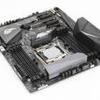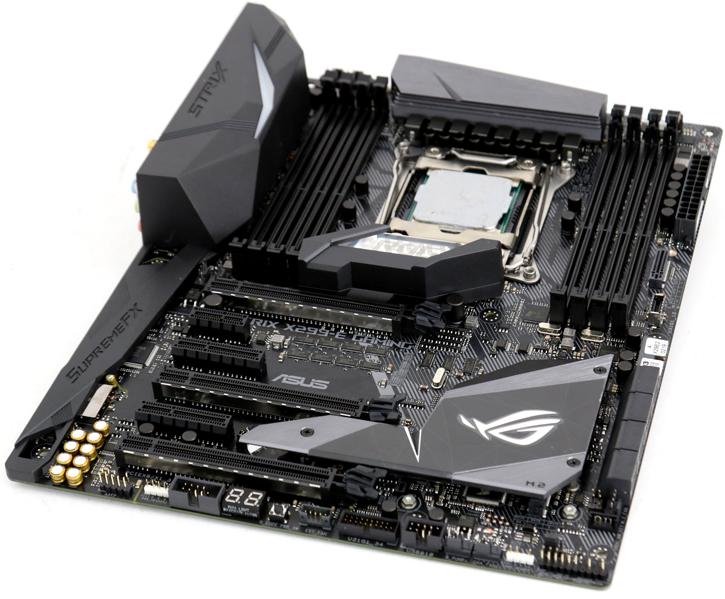Final Words & Conclusion
Final words & conclusion
With the new 0402 and later BIOS I have to say that the X299 platform is changing slowly in a positive way. At default processor settings the load power consumption (while still high) are getting better. This is the same for load temperatures. We ASUS has been tweaking with different power states. Basically what we see is that when all cores are stressed, the lower the clock to roughly 4.0 GHz, however then only 2 to four threads are in use the boost them a bit more. That brings game perf at good number and thus offers other benefits. Can I just say, nice .. ASUS didn't go over the TOP with RGB LEDs. At defaults you'll get subtle rainbow colors, not too much but just right. And from there onward you can configure RGB the way you prefer them to be. I also really like the metal shielding on the PCI slots, I am not sure why ASUS is not doing that for the DIMM slots as well though. So the new STRIX sits in the €349,- / USD domain pricing wise. This price varies a bit per country of course. We very definitely appreciate the proper AC WIFI implementation, it works out really well. I would have liked a 5/10 Gbps Ethernet jack (Aquantia) in this price range though. Overall the ROG STRIX X299-E Gaming offers pretty much what the X299 chipset can push, but that is a fairly feature-rich mobo.
Performance
With the current BIOS (0402) firmware the processor temps remain acceptable, at 70~75 Degrees C under full load conditions. ASUS now as well is bypassing the Intel recommended p-state spec as you can observe from power consumption levels. Intel right now tries to enforce a processor power state that keeps energy power consumption a bit more in line. With most synthetic benchmarks you will not notice huge perf differences. However the lower per core clocks and voltage states have a tremendous negative effect on game performance (in our experience). Once the motherboard manufacturers will disable this 'feature' or if you manually set the CPU Ratios in the BIOS, that P state changes and your game performance jumps up, back to normal and expected levels including games. However, your power consumption will now jump up as well as the temperature, both however lower compared to the levels as seen in the original 7900X review. So yes, there definitely is progress being made with the new firmwares.
Tweaking
A note on VRM heat - during overclocking I pointed my thermal camera at it and the chokes certainly light up, but they always will of course. Power cables however did not show heat levels that worried me. However that 7900X proc is another thing, we halted tweaking as the 1000 USD processor hits 110 Degrees C at relatively moderate settings. We applied an x46 multiplier at all cores and tried the AUTO setting for voltage as well as manual 1.275 and 1.30 Volts. All of them booted fine, the processor simply overheats on the Corsair LCS cooler we used. It even might be a BIOS issue as this was a new yet very dangerous record to see. Hey in good news, we did finish CB at 2500 points though :) Slowly but steadily I am also feeling that the 4600+ MHz clocks simply are too much for Skylake-X, especially long term tweaks. This mobo with a 4 or hexa-core would likely be totally fine, the conundrum seems to be the 7900X. But then again, that's what this platform is made for, so it should be better.
Power consumption
Depending on the hardware p-state the motherboard is fitted with, your numbers will be all over the place. So, with ten cores you get a 140 Watt TDP processor. With the system at idle with a GeForce GTX 1080 installed / 16 GB memory / SSD and the X299 motherboard I hovered at roughly 70 Watts in IDLE. That's just fine really, the load values are however significant. When we stressed the processor in a 100% run we reach roughly 260 Watts with this ten core part (that was a Prime 1024M stress test though). So, we go from 70 Watts towards 260 Watts. When we game we hover at 350 Watts with the GeForce GTX 1080, but obviously that factor is dependent on the type of graphics card and even game you use of course and, sure keep in mind, most games certainly do not utilize the ten CPU cores.
PCI-Express 3.0
We quickly have to discuss PCI-Express lanes, as honestly here is Intel just goofing up. Here is the breakdown:
- Kaby Lake-X quad core gets 16 PCI-Express Lanes 3.0
- Skylake-X six and eight core procs get 28 PCI-Express Lanes 3.0
- Skylake-X ten core procs get 44 PCI-Express Lanes 3.0
DDR4 Memory
Ever since Haswell-E was released along came DDR4 memory. With Skylake-X DDR4 may be clocked a notch faster at 2,677 MHz. Honestly, if you pick up some nice 2,133 MHz DIMMs, at quad-channel they'll offer more than plentiful bandwidth. A 3,200 MHz kit for example is far more expensive and does offer better bandwidth but the performance increases in real-world usage will be hard to notice. Unless you transcode videos over the processor a lot. DDR4 mostly was released for lower voltages and higher frequencies. 2,133 MHz CL 14 or CL 15 memory in combo with quad-channel will already get you to 50~60 GB/sec. While impressive to observe for gaming you will not notice huge performance improvements with high memory bandwidth, but with content creation and video transcoding this kind of bandwidth certainly does make a difference. As always, my advice would be to go with lower clocked DDR4 memory with decent timings, but get more of it. Don't go for 8 GB, get four DIMMs and in total a minimum of 16 GB. And yeah, if you do not care about spending money, check the test page with the G.Skill RGB DIMMs at 3600 MHz, that is brilliant stuff though.
** the latest BIOS updates have lowered power consumption a small notch when overclocked. Also performance overall is more consistent. Tweaked things remain a challenge, but slowly and steadily the early release issues are settling down. We have updated the motherboard with a recommended award. That's just for the motherboard though and says little about the 10 core Intel proc.
The bottom line
Slowly but steadily we see new BIOS updates help out really well with the X299 platform when paired with the beast that is the Core i9 7900X processor. There's more work to be done though. But hey, I can see the power consumption overall drop a bit while the performance is going up a notch, at least for ASUS and MSI. The ROG STRIX X299-E Gaming now among the faster boards we have tested, and the game perf is fixed (the prime had an issue here) thanks to the new BIOS and P-State modes. Progress is made. It however will remain to be a daunting platform in terms of heat and power consumption especially with tweaking in mind. Hardware wise you cannot complain, ASUS is offering something nice here. When watching purely the motherboard then it is all very simple, it is lovely and feature rich enough, has an a proper nice design and feel to it, combined with proper components. Features wise this kit offers many SATA 6 Gbps ports, a Gigabit Ethernet jack and the 7.1 channel HD audio. We like the AC WIFI, we miss 5 Gbit Ethernet anno 2017 though. ASUS did their RGB LEDs implementation right and subtle, I like that. Whether or not the X299 is going to be a success is still debatable as the X299 chipset is fine, the motherboards terrific but the processor, well that's a daunting piece of hardware. Time will tell, but if you are in for an X 299 platform the ROG STRIX X299-E Gaming certainly comes recommended if you stick to defaults or just a minor small tweak. For extensive tweaking, you have seen my comments, I'll leave it at that for now.
Handy related downloads:
- Sign up to receive a notice when we publish a new article
- Or go back to Guru3D's front page.



